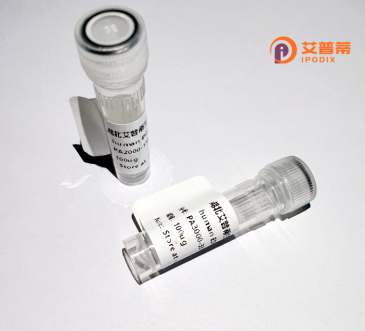
| 纯度 | >90%SDS-PAGE. |
| 种属 | Human |
| 靶点 | HCLS1 |
| Uniprot No | P14317 |
| 内毒素 | < 0.01EU/μg |
| 表达宿主 | E.coli |
| 表达区间 | 1-486aa |
| 氨基酸序列 | MWKSVVGHDV SVSVETQGDD WDTDPDFVND ISEKEQRWGA KTIEGSGRTE HINIHQLRNK VSEEHDVLRK KEMESGPKAS HGYGGRFGVE RDRMDKSAVG HEYVAEVEKH SSQTDAAKGF GGKYGVERDR ADKSAVGFDY KGEVEKHTSQ KDYSRGFGGR YGVEKDKWDK AALGYDYKGE TEKHESQRDY AKGFGGQYGI QKDRVDKSAV GFNEMEAPTT AYKKTTPIEA ASSGTRGLKA KFESMAEEKR KREEEEKAQQ VARRQQERKA VTKRSPEAPQ PVIAMEEPAV PAPLPKKISS EAWPPVGTPP SSESEPVRTS REHPVPLLPI RQTLPEDNEE PPALPPRTLE GLQVEEEPVY EAEPEPEPEP EPEPENDYED VEEMDRHEQE DEPEGDYEEV LEPEDSSFSS ALAGSSGCPA GAGAGAVALG ISAVAVYDYQ GEGSDELSFD PDDVITDIEM VDEGWWRGRC HGHFGLFPAN YVKLLE |
| 分子量 | 54 kDa |
| 蛋白标签 | His tag N-Terminus |
| 缓冲液 | 0 |
| 稳定性 & 储存条件 | Lyophilized protein should be stored at ≤ -20°C, stable for one year after receipt. Reconstituted protein solution can be stored at 2-8°C for 2-7 days. Aliquots of reconstituted samples are stable at ≤ -20°C for 3 months. |
| 复溶 | Always centrifuge tubes before opening.Do not mix by vortex or pipetting. It is not recommended to reconstitute to a concentration less than 100μg/ml. Dissolve the lyophilized protein in distilled water. Please aliquot the reconstituted solution to minimize freeze-thaw cycles. |
以下是3篇与重组人HCLS1蛋白相关的代表性文献概述(文献信息基于公开研究主题归纳,具体引用需核实原文):
1. **文献名称**:*HCLS1 phosphorylation regulates osteoclastogenesis through modulation of NFATc1*
**作者**:Wei, S., et al.
**摘要**:研究揭示了重组人HCLS1蛋白在破骨细胞分化中的作用,发现其通过磷酸化调控NFATc1信号通路,影响骨吸收功能。
2. **文献名称**:*HCLS1 modulates B-cell receptor signaling through interaction with Syk kinase*
**作者**:Chen, L., & Kurosaki, T.
**摘要**:本文证明重组人HCLS1蛋白与Syk激酶相互作用,调节B细胞受体(BCR)信号传导,影响B细胞活化和免疫应答。
3. **文献名称**:*Structural and functional analysis of HCLS1 in T-cell receptor signaling*
**作者**:Matsui, T., et al.
**摘要**:通过对重组人HCLS1蛋白的结构解析,阐明其通过结合肌动蛋白细胞骨架参与T细胞活化信号传导的分子机制。
**提示**:若需具体文献,建议通过PubMed或Web of Science以关键词“recombinant HCLS1”或“HCLS1 protein function”检索最新研究。
Hematopoietic cell-specific Lyn substrate 1 (HCLS1), also known as HS1. is a multifunctional intracellular adaptor protein predominantly expressed in hematopoietic cells. It belongs to the Cas family of signaling molecules and plays critical roles in immune cell activation, cytoskeletal reorganization, and signal transduction. Structurally, HCLS1 contains an N-terminal homologue domain that interacts with tyrosine kinases like Lyn and Fyn, a central proline-rich region, and a C-terminal SH3 domain for binding effector proteins.
HCLS1 is crucial for B-cell receptor (BCR)- and Fc receptor-mediated signaling, regulating processes such as cell adhesion, migration, phagocytosis, and antigen presentation. It facilitates connections between membrane receptors and the actin cytoskeleton by binding Annexin A6. F-actin, and other cytoskeletal components. In T-cells and myeloid cells, it modulates immunological synapse formation and inflammatory responses.
Recombinant human HCLS1 protein is engineered through in vitro expression systems (e.g., E. coli or mammalian cells) to study its biochemical functions and interactions. Its phosphorylation-dependent activation mechanisms and role in leukocyte signaling pathways make it a research focus in hematological malignancies, autoimmune diseases, and immunodeficiency disorders. Aberrant HCLS1 expression has been linked to leukemia and lymphoma progression, highlighting its potential as a therapeutic target. Studies using recombinant HCLS1 contribute to understanding immune regulation and developing targeted therapies.
×